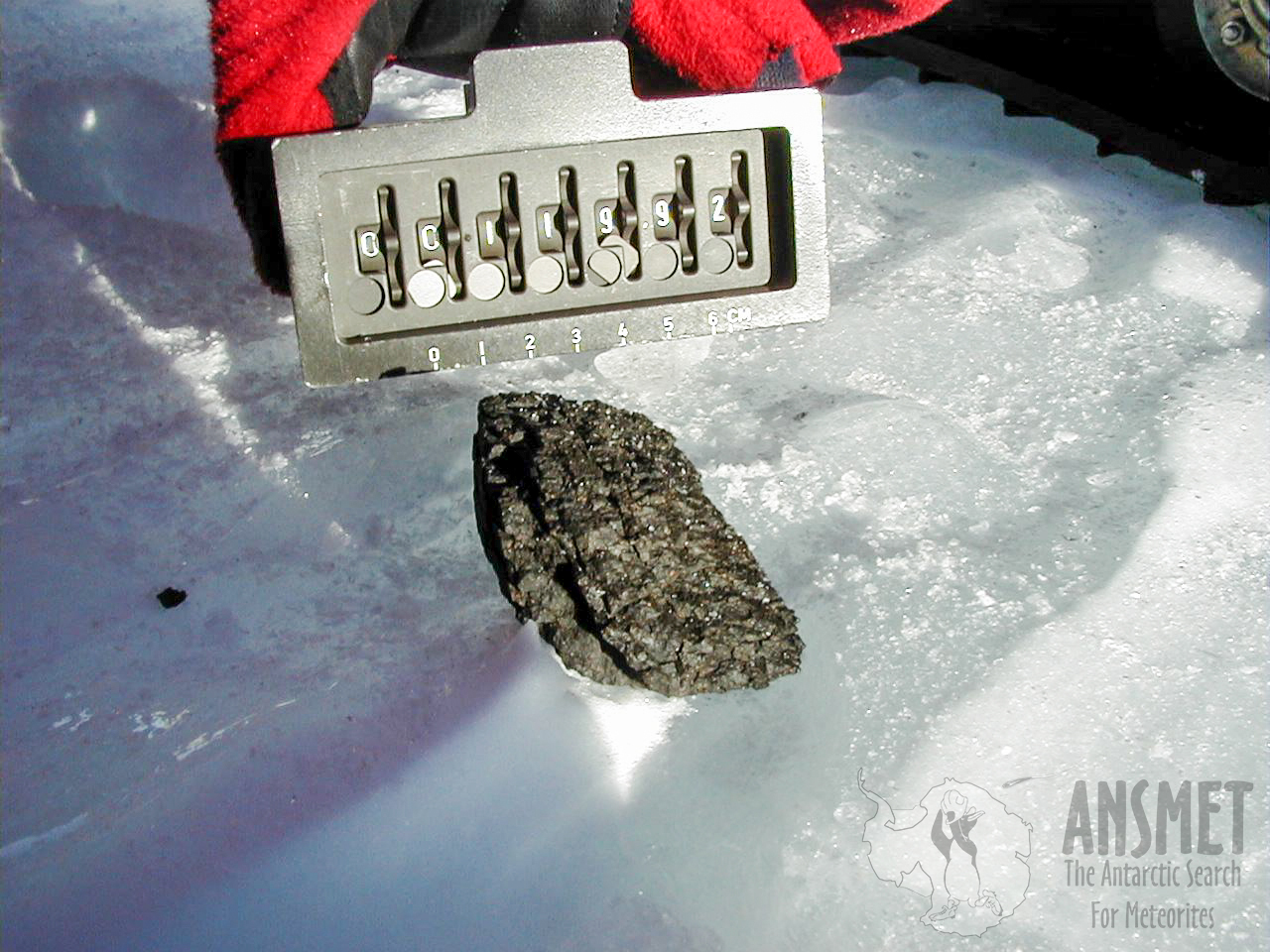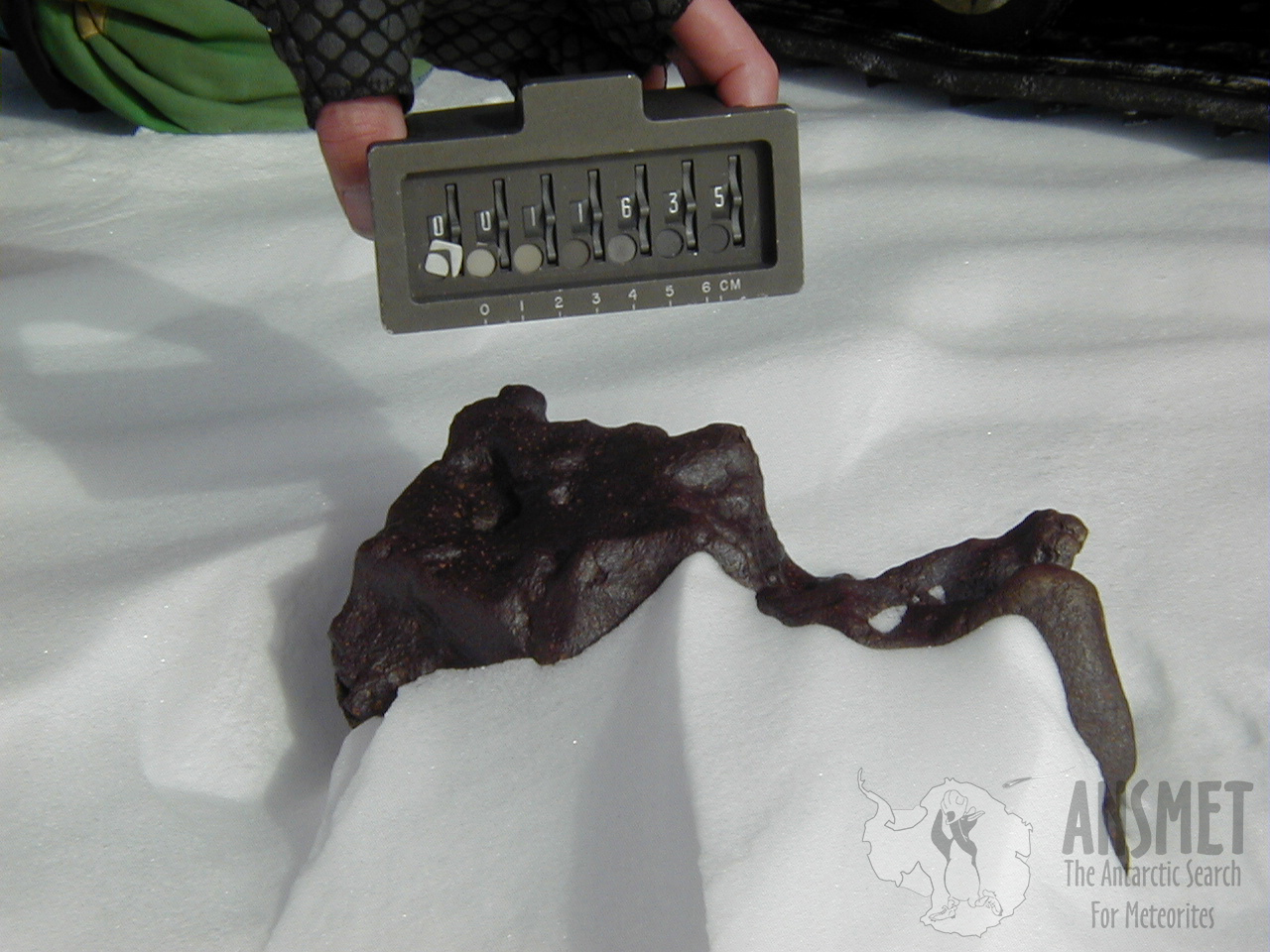Antarctic Meteorite Sample Collection and Curation
Field Information
Images of Meteorites
Many images of ANSMET meteorite samples are available on our webpage on the detailed description pages for specific samples. The principal purpose of the images is to establish the context of each find and to serve as a record corroborating field number, size and fusion crust data collected during sample recovery.

ANSMET GRA 98005 - Field Number 11992, NASA Photo Number: JSC2018E087419

ANSMET QUE 99001 - Field Number 11635, NASA Photo Number: JSC2018E092034
There are a number of qualifying statements that must be made so the users of these images can understand the issues regarding their availability and use:
- While imagery documenting sample recovery began early in ANSMET's history, systematic photography didn’t begin until 1980, and the quality of the images is variable (and sometimes poor). We have several types of images from ANSMET teams including: a) PI Bill Cassidy provided his slide originals in 2007 that we had scanned and image quality optimized; these cover the timeframe between 1976-1988; b) images that were assigned official NASA S#s in the 1980-1983 timeframe that are now available in digital form; c) images from PI Ralph Harvey that begin with the 1997-98 field seasons and extend to the present.
- In the early 1990’s the decision was made to only take pictures of specimens thought to be of interest. Digital cameras were first employed in the late 1990’s, but again the quality was routinely poor. The 1997-1998 collection marked the return of selective systematic imaging as digital camera technology matured; still only about 50% were imaged that year. Photography of individual finds wasn’t a formal requirement until the early 2000’s (when USAP’s federal regulations on Antarctic meteorite recoveries were implemented). Over the ensuing years, as camera imaging technology and battery life improved, the imagery for each season became more and more complete. A lot of images are of inconsistent or poor quality, especially in the earliest years when pixel resolution was low and technologies like auto-focus and auto-exposure were unsophisticated. Not every sample was imaged due to camera malfunctions, often due to the cold. There are samples where the field number on the counter was incorrect. These cases have all been caught and corrected, and notation made in the records, but it may not be obvious on the webpage.
- Most of the images were taken horizontally, just above the ice surface, with the identification counter held above and/or slightly behind the meteorite. In some images the viewing perspective removes the third dimension and suggests the sample was being touched. This is an illusion and almost never the case; but when it has actually happened it’s been noted in the field notes.
- The specific person taking an image hasn’t been noted; the role of portrait photographer is commonly shared among the field party members, though in later years one or two individuals were often designated to be primary photographers to help manage the process and help ensure some uniformity to the imagery.
Usage Guidelines: ANSMET is a competitively-funded university-based project, historically supported either by NASA or NSF or both. From 1976 to 1994, ANSMET PI was Dr. William Cassidy of University of Pittsburgh, and from 1994 to 2017 the program’s home was Case Western Reserve University (CWRU) with PI Dr. Ralph P. Harvey.
Currently, ANSMET is led by Co-PIs Dr. Harvey at CWRU, and Dr. James Karner at the University of Utah. The ANSMET project plans, manages and implements the recovery of Antarctic Meteorites and operates independent of later curatorial work. Because of this, we feel it is important that the
ANSMET program be noted as the originator of the field portraits (not NASA–JSC or any other group) even though JSC maintains the archive to go with sample information. Each image is thus watermarked with a black/white ANSMET logo clearly stating the image’s origin with ANSMET.
These images are available for use through the public domain, but must be credited with the following statement:
“Image courtesy of the ANSMET (Antarctic Search for Meteorites) Program, Case Western Reserve University, the University of Utah, and NASA Johnson Space Center Astromaterials Curation Group”. We request that we be notified immediately when a provided image is published in any form, digital or print.
For some images, higher resolution versions are available and can be obtained by contacting Kevin Righter or Cecilia Satterwhite of the Antarctic Meteorite collection.
Find Locations
Position data has been derived from a variety of surveying techniques (primarily GPS since the early 1990's) used by ANSMET field teams and reflects a typical uncertainty of around 10 m. The data has been truncated to avoid confusing high precision (many decimal places) with high accuracy (low error). These positions reflect a realistic “best available” accuracy, at ˜50x higher resolution than required by federal regulations.
